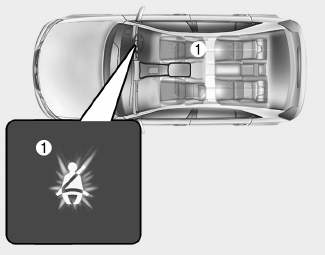Hyundai i-30: If you have a flat tyre (with tyre mobility kit) / Using the Tyre Mobility Kit
CAUTION

Detach the speed restriction label (1) from the sealant bottle (2), and place it in a highly visible place inside the vehicle such as on the steering wheel to remind the driver not to drive too fast.
1. Shake the sealant bottle (2).

■ Type A

■ Type B
2. Connect the filling hose (3) to the sealant bottle (2) in the direction of (A) and connect the sealant bottle to the compressor (6) in the direction of (B).
3. Ensure that the compressor is switched OFF.
4. Unscrew the valve cap from the valve of the defective wheel and screw the filling hose (3) of the sealant bottle onto the valve.

CAUTION
Securely install the sealant filling hose to the valve. If not, sealant may flow backward, possibly clogging the filling hose.


5. Plug the compressor power cord (4) into the vehicle power outlet.
NOTICE
Only use the front passenger side power outlet when connecting the power cord.
6. With the ignition switch in the ON position, switch on the compressor and let it run for approximately 5~7 minutes to fill the sealant up to proper pressure. (refer to the Tyre and Wheels, chapter 8). The inflation pressure of the tyre after filling is unimportant and will be checked/corrected later.
Be careful not to overinflate the tyre and stay away from the tyre when filling it.
CAUTION
Tyre pressure
Do not attempt to drive your vehicle if the tyre pressure is below 200 kPa (29 psi). This could result in an accident due to sudden tyre failure.
7. Switch off the compressor.
8. Detach the hoses from the sealant bottle connector and from the tyre valve.
Return the Tyre Mobility Kit to its storage location in the vehicle.
WARNING
Carbon monoxide
Do not leave your vehicle running in a poorly ventilated area for extended periods of time. Carbon monoxide poisoning and suffocation can occur.
Distributing the sealant

9. Immediately drive approximately 7~10 km (4~6 miles or, about 10min) to evenly distribute the sealant in the tyre.
Do not exceed a speed of 80 km/h (50 mph). If possible, do not fall below a speed of 20 km/h (12 mph).
Whilst driving, if you experience any unusual vibration, ride disturbance or noise, reduce your speed and drive with caution until you can safely pull off of the side of the road.
Call for road side service or towing.
 Components of the Tyre Mobility Kit
Components of the Tyre Mobility Kit
■ Type A
■ Type B
1. Speed-restriction label
2. Sealant bottle and label with speed
restriction
3. Filling hose from sealant bottle to
wheel
4...
 Checking the tyre inflation
pressure
Checking the tyre inflation
pressure
1. After driving approximately 7~10
km (4~6 miles or about 10 min),
stop at a safety location.
2. Connect the filling hose (3) of the
compressor directly to the tyre
valve...
Other information:
Hyundai i30 (PD) 2018-2025 Owner's Manual: Welcome system
Welcome light Puddle lamp When all the doors (and tailgate) are closed and locked, the puddle lamp will come on for about 15 seconds if any of the below is performed. When the door unlock button is pressed on the remote key or smart key...
Hyundai i30 (PD) 2018-2025 Service Manual: Description and operation
Description System Overview The System offers the following features: – Changing the state of engine ignition and power by using the start button. – Controlling external relays for ACC / IGN1 / IGN2 terminal switching and STARTER, without use of mechanical ignition switch...
Categories
- Manuals Home
- 3rd Generation i30 Owners Manual
- 3rd Generation i30 Service Manual
- Trip computer
- To activate the ISG system
- Jump starting procedure
- New on site
- Most important about car
Seat belt warning light
Seat belt warning
Driver’s seat belt warning

■ Instrument cluster
As a reminder to the driver, the seat belt warning light will illuminate for approximately 6 seconds each time you turn the ignition switch ON regardless of belt fastening.
